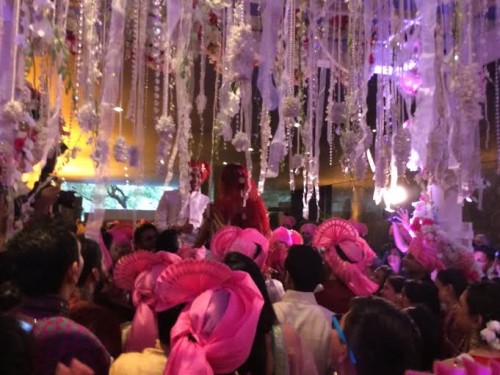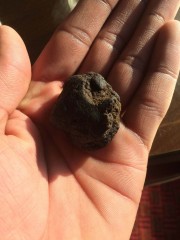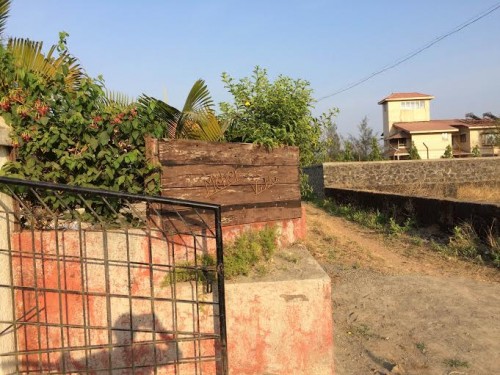LONAVALA, India — I lit the spliff of charas and took a quick hit as I felt myself melt into the swing. I began to rock myself back and forth as a slight breeze rustled through my hair — a welcome contrast to the sun beaming down on my face. I was sitting in the garden of a bungalow in a Zoroastrian resort nestled in the hills outside of Mumbai, India, and you might say life was pretty damn fine at that very moment in December 2015.
Aside from the taste of the Marlboro Gold tobacco, the spliff produced a sweet, creamy smoke with hints of an indiscernible floral taste that finished with a harsh spiciness on the back of my tongue and throat. Between the crude production process and the nature of “stepping” on black-market intoxicants, I’d guess that this product was no more than 30 percent THC and possibly contained some adulterants (or cut).
And that’s when the beauty of the situation hit me. Half a world from home and all my work responsibilities, surrounded by my extended family, I was fortunate enough to experience one of the unique cannabis products of India — charas, or pressed hash. And I couldn’t help but reflect on how I found myself there.
***
Earlier that morning a flock of crows flew eye-level with three hawks circling above them, their wings cutting through the smog as they wove through the many apartment buildings in Chembur. With a couple million people, the city is nothing more than a suburb of Mumbai, a bustling metropolis of more than 20 million. I had just finished packing my weekend bag and was enjoying a smoke while I waited for the rest of the family to get ready. The smog was so bad that Apple’s Weather app told me the day’s forecast looked “smokey” with a high of 90 degrees. I checked my e-mail one last time before my family left the city (and its wi-fi) for the weekend.
More Cannabist travelogues from around the world
In San Francisco: On a ganja yoga retreat, too-tasty pot pretzels and a deeper understanding
In Jamaica: Why isn’t Rastafari a respected religion? Because of pot prejudice
In Colorado: Pot tourism goes upscale in the Rocky Mountains
In Seattle: How Washington’s largest weed event compares to Colorado’s largest 420 party
In Morocco: Looking to this Muslim nation as it considers medical pot
In the Bay Area: Check out these northern California dispensary lounges
NEW: Get podcasts of The Cannabist Show.
Subscribe to our newsletter here.
Watch The Cannabist Show.
Turns out my own personal forecast was looking pretty “smokey,” too — but I’ll get there soon enough.
The intercom phone rang. About 20 seconds later, the maid popped her head into my room and said, “Aap neeche bula ra hain,” letting me know the cars were ready for our weekend trip and that I was being summoned downstairs. She sent my bag down while I finished my smoke and grabbed a bottle of water for the ride. Our car, packed tight with my brother, cousin and cousin’s wife, was the first out of the gate.
The digital clock in the car read just past 11 a.m. as we sped away from the congested toll booth and pulled into a rest stop for my favorite Indian street food, vada pav, a deep-fried ball of seasoned potatoes served on a slider bun. The food court was packed with people huddled around standing tables eating and drinking chai. We ordered food for the 15 people in our group and got back on the highway towards Lonavala, a village in the hills southeast of Mumbai known colloquially as a “hill station.”
After our three-car convoy missed the unmarked dirt road right off the highway and drove 15 miles past our destination, we turned around. We eventually found the right dirt road, and it only took asking four people in the local, state-specific language, Marathi. We finally arrived at the resort at which we were spending the weekend, Meher Villa.
We basically took over the resort for the weekend, having booked six of the seven villas and the large bungalow on the property. As everyone got settled, I decided to explore a little. I started at the common building, which functioned as a dining hall and recreation room, when I noticed the decor.
Pictures of old, guru-looking men with long locks and facial hair covered the walls with inspirational quotes. Two small framed pictures above the door informed me that their names were Lord Zoroaster and the namesake of the resort, Lord Meher (Meher Baba). I wasn’t deeply familiar with them but I assumed that this resort was founded or owned by Zoroastrians. Above the dining table was a large portrait of Lord Meher, flanked by a quote that stood out to me:
“Real happiness lies in making others happy.”
I have never been a religious person, but I was captivated by this quote, staring at it for several minutes before continuing my exploration. I ventured back to the bungalow where we were staying and decided it was time for a smoke.

A week prior I’d arrived in Mumbai for another cousin’s wedding. Aware of my love for cannabis, one of her friends had a ping pong ball-sized block of pressed hash waiting for me. I was deeply appreciative, knowing that the half-tola (5ish grams) block would likely last through the entirety of my two-week trip — as well as save me 2,000 rupees (around $30 USD). If I made the trek up to the hills of Manali on my own, I could probably get a full tola (10ish grams) for the same price. Conversely, I could step outside one of my favorite spots in South Bombay’s Colaba district, the Leopold Cafe, and find some on my own — although I’d probably end up paying the “tourist premium,” which is roughly double the price for shittier product.
This type of pressed hash is known locally as charas. It is one of the three commonly consumed forms of cannabis in India — the other two being an infused milk-based beverage known as bhang (not the brand of infused chocolates you see in Colorado marijuana stores) and flower known as ganja. I have yet to find ganja or bhang in India, but through local friends I’m usually able to find charas when I visit. Most of what we find in Bombay probably comes from the high-altitude indica landraces that are grown in the high country of Himachal Pradesh, India’s northern-most state (just south of disputed Jammu and Kashmir).
Known as Manali Cream, charas is made by rubbing the resin of live plants between the hands to produce a dark, sticky hash. As the famous breeder and self-proclaimed “King of Cannabis” Arjan Roskam pointed out on the “Strain Hunters” episode, India is one of the only places in the world in which hash is pressed from live plants — as opposed to the dried flower that is used in Moroccan production.

While the use of cannabis is technically illegal in India, it is generally unenforced. On the off chance you’re hassled by police, they are more than likely just looking to have their palms greased.
Just days before my departure I was down to the final gram and half. I sat at the dining table and took out my smoking wears — the dark, pressed hash, orange Zig Zag 1-1/4s (that I brought from Denver) and a half-smoked pack of Indian Marlboros. Having had the opportunity to smoke in Europe, Africa and Asia, I was accustomed to the pressed hash and tobacco spliffs that are common in those (and other) parts of the world.
I broke off a glob the size of my fingernail and started to make small pieces with my hand. I realized the black color on the outside was actually a very dark brown when I broke it down. It was a lighter shade of golden brown on the inside. It had a sweet, floral scent and was sticky and malleable. The small pieces were mostly smooth with a slightly grainy texture. I gently rolled a cigarette between my thumb and index finger to loosen half of the tobacco and let it fall into the prepped Zig Zag. Then I mixed in the broken hash and stirred it with the empty tip of the cigarette. I finished rolling the spliff and went to the swing in the garden outside the bungalow to smoke.
And as I smoked, my body and eyes relaxed even more, and I began to contemplate the Zoroastrian-themed decor around the resort. I was invigorated from nearly two weeks without Internet and e-mail, but I suddenly wished I could go online — not to check the inevitable barrage of work emails, but to learn more about this ancient Parsi religion. I was not sure why, but the Zoroastrian quote from earlier resonated with me even more in my stoned state.
“Real happiness lies in making others happy.”
Unfortunately for this task (but likely for the better) there was no wi-fi at the resort, so I finished my spliff and went back to the main courtyard where people were starting to emerge from their villas for afternoon chai.

Someone asked the resort staff if they had any sports equipment, and they ably provided a plastic cricket set and a tennis ball. With six of our eight cousins there, we started to play. Despite the relaxing and generally sedative nature of the hash, my reactions were quick enough to make a couple diving catches.
“Still got it,” I thought to myself quietly.
In my post-smoke state, I lost myself in mid-game introspection and reminisced about the many evenings we’d spent playing cricket inside the gated compound of our family’s Mumbai bungalow, going back more than 20 years. The only difference was the constant “Game off” and “Game On,” caused by our niece, Alisha, running through the game. I could almost hear my late Nani (maternal grandmother) yelling at us to put on our shoes or come inside to get ready for dinner. We played for an hour or so until the afternoon sun herded everyone to the pool area.
We enjoyed the rest of the evening and weekend and went back to Mumbai, where I boarded a flight that night and came home to Colorado.
When I got back to Denver and was finally able to learn more about Lord Zoroaster and Meher Baba, I immediately understood the connection I had felt after smoking. As it turns out, Lord Zoroaster was said to have consumed bhang, which was referred to as his “good narcotic.”
Lord Zoroaster was hardly the first or only eastern religious leader to advocate for the spiritual use of cannabis. He is, however, one of the least well-known. After leaving Persia to escape religious persecution, he settled in Gujarat in northern India where he was free to consume cannabis and exercise his religion. The combination of cannabis and the environment led me to contemplate the local culture in a unique way, and it left me yearning to experience the production of charas first-hand.
I only make it to India once every other year. However, I feel comfortable saying that my next trip to India will definitely include a backpacking trek up to Manali where, like Roskam and the “Strain Hunters” crew, I will witness first-hand the anachronistic manufacture of one of the world’s most legendary hash products.
